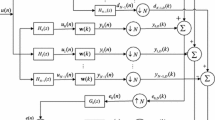Abstract
In this paper, we consider the sparse filter design problem where some of the coefficients can be reduced to zeroes in order to lower implementation complexity. The objective is to choose the fewest number of nonzero filter coefficients to meet a given performance requirement. We formulate a discrete optimization problem to minimize the number of nonzero terms and develop a discrete search method to find the minimal nonzero terms. In each step, we need to consider a subproblem to design the filter coefficients with a given set of nonzero terms. We formulate this subproblem as a linear programming problem and apply an exchange algorithm to find the optimal coefficients. For illustration, we compare the proposed algorithm with existing methods and show that the proposed method gives better results in all our test cases.




Similar content being viewed by others
References
T. Baran, D. Wei, A.V. Oppenheim, Linear programming algorithms for sparse filter design. IEEE Trans. Signal Process. 58(3), 1605–1617 (2010)
C.L. Chen, A.N. Willson, A trellis search algorithm for the design of FIR filters with signed-powers-of-two coefficients. IEEE Trans. Circuits Syst. II(46), 29–39 (1999)
Z.G. Feng, K.L. Teo, A discrete filled function method for the design of FIR filters with signed-powers-of-two coefficients. IEEE Trans. Signal Process. 56(1), 134–139 (2008)
Z.G. Feng, K.F.C. Yiu, S. Nordholm, A two-stage method for the design of near-field multi-dimensional broadband beamformer. IEEE Trans. Signal Process. 59(8), 3647–3656 (2011)
Z.G. Feng, K.F.C. Yiu, S. Nordholm, Performance limit of broadband beamformer designs in space and frequency. J. Optim. Theory Appl. 164, 316–341 (2015)
R.P. Ge, A filled function method for finding a global minimizer of a function of several variables. Math. Program. 46, 191–204 (1990)
J.T. Kim, W.J. Oh, Y.H. Lee, Design of nonuniformly spaced linear-phase FIR filters using mixed integer linear programming. IEEE Trans. Signal Process. 44(1), 123–126 (1996)
R.M. Leahy, B.D. Jeffs, On the design of maximally sparse beamforming arrays. IEEE Trans. Antennas Propag. 39(8), 1178–1187 (1991)
J.K. Liang, R.D. Figueiredo, F. Lu, Design of optimal Nyquist, partial response, Nth band, and nonuniform tap spacing FIR digital filters using linear programming techniques. IEEE Trans. Circuits Syst. 32(4), 386–392 (1985)
Y.C. Lim, Frequency-response masking approach for the synthesis of sharp linear phase digital filters. IEEE Trans. Circuits Syst. 33, 357–364 (1986)
Y.C. Lim, Y. Lian, Frequency-response masking approach for digital filter design: complexity reduction via masking filter factorization. IEEE Trans. Circuits Syst. 41, 518–525 (1994)
Y.C. Lim, S.R. Parker, FIR filter design over a discrete powers-of-two coefficient space. IEEE Trans. Acoust. Speech Signal Process. 31, 583–591 (1983)
W.S. Lu, T. Hinamoto, Digital filters with sparse coefficients, in Proceedings of 2010 IEEE International Symposium on Circuits and Systems (ISCAS), pp. 169–172, Paris, France (2010)
C.K. Ng, L.S. Zhang, D. Li, W.W. Tian, Discrete filled function method for discrete global optimization. Comput. Optim. Appl. 31, 87–115 (2005)
Y.S. Song, Y.H. Lee, Design of sparse FIR filters based on branch and bound algorithm, in Proceedings of the 40th Midwest Symposium Circuits and Systems, vol. 2 (1997)
J.L.H. Webb, D.C.M. Jr, Chebyshev optimization of sparse FIR filters using linear programming with an application to beamforming. IEEE Trans. Signal Process. 44(8), 1912–1922 (1991)
K.F.C. Yiu, M.J. Gao, T.J. Shiu, T. Tran, S.Y. Wu, I. Claesson, A fast algorithm for the optimal design of high accuracy windows in signal processing. Optim. Methods Softw. 28(4), 900–916 (2013)
Y.J. Yu, Y.C. Lim, Design of linear phase FIR filters in subexpression space using mixed integer linear programming. IEEE Trans. Circuits Syst. I 54(10), 2330–2338 (2007)
Acknowledgements
This work is supported by RGC Grant PolyU. (152200/14E) and PolyU Grant 4-ZZGS. The first author is also supported by the National Natural Science Foundation of China (No. 61673078), the Grant of Chongqing Science and Technology Commission (No. cstc2017jcyjAX0161) and the Grant of Chongqing Normal University (No. 17XLB010).
Author information
Authors and Affiliations
Corresponding author
Rights and permissions
About this article
Cite this article
Feng, Z.G., Yiu, K.F.C. & Wu, S.Y. Design of Sparse Filters by a Discrete Filled Function Technique. Circuits Syst Signal Process 37, 4279–4294 (2018). https://doi.org/10.1007/s00034-018-0758-z
Received:
Revised:
Accepted:
Published:
Issue Date:
DOI: https://doi.org/10.1007/s00034-018-0758-z




